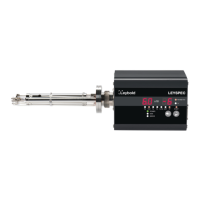300781172_002_C0 - 012/2019 - © Leybold 82
Appendix
1. The ionization probability in the ion source varies with the type of gas as with the
ionization gauge.
2. The higher the mass number, the lower the transmitting efficiency of the
quadruple section.
3. The amplification factor of the secondary electron multiplier tube varies with the
ion species.
To read the spectrum value of each gas as the amount of gas, feed mixture gas with
a known volume ratio and find the sensitivity factor for each gas.
13.4.2 Cracking pattern
1. Ions dissociated in ionization
2. Divalent ion
3. Isotope, and so forth.
Cracking patterns appear when multiple spectra appear with one type of gas, and
this occurs with most types of gases. The mass number of residual gas in an
ordinary vacuum system is 50 or less and the number of cracking patterns is small,
so that it is relatively easy to analyse them, but if organic gas is mixed, it is difficult
to analyse the cracking pattern.
13.4.3 Overlapping peaks
Since a gas species is identified with mass number, it is difficult to separate gases
with the same mass number. For example, N
2
and CO that are present as residual
gas have cracking patterns at mass numbers 14 and 12 respectively, it is possible
to judge them to some extent, but it is not easy to find the ratio and partial pressure
accurately because the peaks overlap.

